
Dr. Jacques Fontaine is a thoracic surgeon at Moffitt Cancer Center in Tampa, Florida, where he heads up the Mesothelioma Research and Treatment Center. He specializes in minimally invasive robotic surgery and aggressive surgeries for mesothelioma.
Written by Dr. Daniel Landau | Edited by Amy Edel | Medically Reviewed by Dr. Jacques Fontaine
Mesothelioma isn’t a common cancer. In fact, it’s quite rare. For every 100,000 people in the United States, fewer than 1 new mesothelioma case was reported in 2021, according to the latest available data from the Centers for Disease Control and Prevention and National Cancer Institute’s U.S. Cancer Statistics Working Group. There were 2,803 new mesothelioma cases reported in the U.S. in 2021, the latest year of available data.
Doctors diagnosed 72,779 new cases of mesothelioma cancer in the U.S. from 1999 to 2021. Since 1999, the highest number of new mesothelioma cases reported in the U.S. occurred in 2011, with 3,376 diagnoses. While cases were trending down in 2020 and 2021, the COVID-19 pandemic may have delayed diagnoses during this time period.
Learn about your diagnosis, top doctors and how to pay for treatment in our free mesothelioma guide.
Get Your GuideThe most recent federal mesothelioma data is from 2021 because it takes time to gather, carefully assess and report accurate information from participants in the National Program of Cancer Registries and the National Cancer Institute’s Surveillance, Epidemiology and End Results Program. This detailed and extensive national process is why there’s often a delay before newer numbers are available.
Peritoneal mesothelioma survivor and advocate Tamron Little understands just how rare this cancer is. She tells us, “Mesothelioma is a very rare cancer. The first oncologist I saw was honest and said he didn’t know anything about peritoneal mesothelioma. After that visit, I was determined to find a mesothelioma specialist.”

Mesothelioma incidence rates vary across the United States. Data from the United States Cancer Statistics (USCS) Working Group, a collaboration between the CDC and the National Cancer Institute’s (NCI) SEER Program, shows significant geographic differences.
California, Pennsylvania, Washington and other states with long histories of shipbuilding, oil refining and asbestos manufacturing report high mesothelioma rates. In 2021, California had 284 new cases, Florida 237 and Texas 206. USCS Working Group data from 2021 shows the mesothelioma incidence rate in Washington state was 0.9 per 100,000 people. The mesothelioma incidence rate in Pennsylvania was 0.8 per 100,000 people in 2021.
Highest Rates Per 100K People
California, Pennsylvania, Texas, New York and Ohio had the highest mesothelioma-related mortalities between 2016 and 2021. Delaware’s mortality rate from 2018-2021 was 1 per 100,000 people. Maine’s was 1 per 100,000. Alaska’s was 1.2 per 100,000. Puerto Rico had a mortality rate of 0.1 per 100,000. Georgia had a mortality rate of 0.4 per 100,000.


We’ll get you the best doctor for your diagnosis and schedule appointments with them quickly.
Find My DoctorThe No. 1 cause of mesothelioma is occupational exposure to asbestos. According to research from the National Institute for Occupational Safety and Health (NIOSH), people working in industries that once heavily relied on asbestos, including construction, shipyards, manufacturing, and the U.S. military, have had the highest mesothelioma incidence.
Researchers from the Respiratory Health Division, National Institute for Occupational Safety and Health, the University of Pittsburgh and Indiana University published a study in Environmental Research in 2023. The study maps occupations, industries and mesothelioma incidence from 2006-2022. The study confirmed that industrial and military exposure continues to drive most U.S. mesothelioma cases.
Mesothelioma Cases by Occupation From 2006-2022
Family members of workers exposed to asbestos can develop it from secondary exposure. Secondary exposure is the most common way women are exposed to asbestos, affecting about 44% of women compared to 3% of men.
The highest incidence rates occur in regions with histories of industrial and asbestos-heavy industries. Mesothelioma incidence rates describe the risk of developing this cancer.
Where tumors first develop affects mesothelioma statistics. The incidence rate of pleural mesothelioma is significantly higher than for any other type. About 80% of cases occur in the pleura, the smooth tissue surrounding the lungs.
About 20% of cases are peritoneal mesothelioma. This occurs when tumors appear in the peritoneum, the smooth lining of the abdomen. About 1% are pericardial cases. This mesothelioma type forms in the heart’s lining, the pericardium. Fewer than 1% of mesothelioma cases are testicular. Tumors of this type occur in the tunica vaginalis, the lining covering of the testes.
Tumor location also affects survival rates. About 73% of patients with pleural mesothelioma survive 1 year. The 5-year survival rate is 12%. For peritoneal mesothelioma, 92% survive 1 year. The 5-year survival rate is 65%. For pericardial mesothelioma, 26% survive 1 year. The 5-year survival rate is 9%.
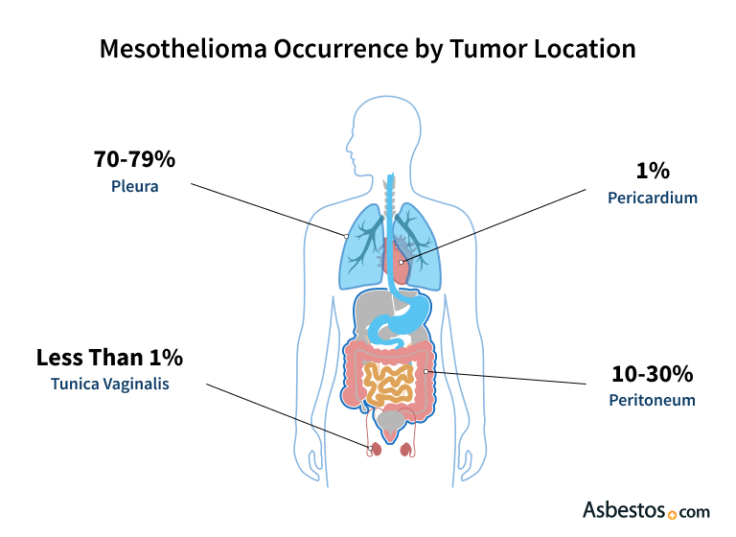
Treatment has a significant impact on life expectancy for patients. Mesothelioma treatment may involve surgery, immunotherapy. chemotherapy or radiation therapy. Important advances in mesothelioma treatment are improving survival for patients.
A recent study presented at the European Lung Cancer Congress looked at combining 2 or more mesothelioma treatment options, known as a multimodal approach. It showed a 1-year survival rate of 79.6% for pleural mesothelioma patients who underwent a combination of surgery, chemo and radiation.
Treatment’s Effect on Mesothelioma Survival
An International Journal of Hyperthermia study showed the median disease-free survival was almost 5 years for peritoneal patients receiving HIPEC surgery. The median overall survival was more than 8 years.
Clinical trials give patients access to breakthrough treatments. Another key to successful outcomes is beginning treatment as early as possible. Mesothelioma symptoms also often don’t appear until people are already in later stages. Regular screenings for those with asbestos exposure can help catch the disease early.

Learn about the latest mesothelioma treatments and clinical trials in our updated 2025 guide.
Get Your Free GuideGovernment agencies break down and study mesothelioma statistics among different demographics to help understand risk and prognosis. Different ages, genders, races or ethnicities have different incident rates.
This information also helps agencies identify and address disparities in access to screenings, diagnosis and treatment. As the Utah Department of Health and Human Services explains, “Analysis of public health data by demographic characteristics is essential to the reduction and elimination of health disparities.”
CDC data from 2021 showed 33% of people diagnosed with mesothelioma were 80 or older. People between the ages of 75-79 comprised 19% of new cases in 2021. About 4% of cases were among people between the ages of 35-49.
The latency period is generally shorter for peritoneal mesothelioma than for pleural mesothelioma. Most people diagnosed with peritoneal and pleural mesothelioma are about 51 and 67 years old, respectively.
Mesothelioma survivor Tamron tells us she wasn’t in the usual age demographic when diagnosed. She shares, “I was just 21 years old. My case was as rare as you can get.”

Younger patients have significantly higher mesothelioma survival rates than older patients. More than 50% of patients diagnosed before the age of 50 survive 1 year, while fewer than 33% of those 75 or older survive the same length of time.
There were 502 mesothelioma deaths among patients ages 85 and older in 2022, the latest year for which data on mortality by age is available. That same year, 21 people between the ages of 45 and 49 died of mesothelioma.
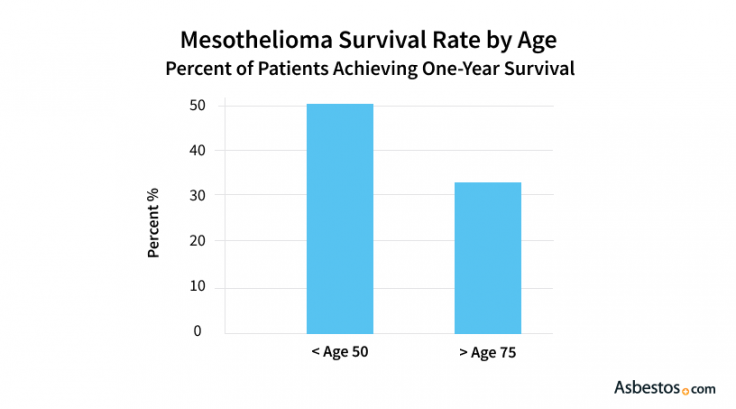
Historically, mesothelioma has been primarily diagnosed in men. According to the CDC’s United States Cancer Statistics, men made up 70% and women 30% of new mesothelioma cases in the U.S. in 2021. There were 1,973 new mesothelioma cases among men and 830 in women.
Women at the highest risk of developing mesothelioma from asbestos exposure are registered nurses, homemakers and teachers in elementary and middle school. A recent study found among people older than 44 years, mesothelioma incidence rates were higher among men. Among those younger than 45 years, women had higher incidence rates.
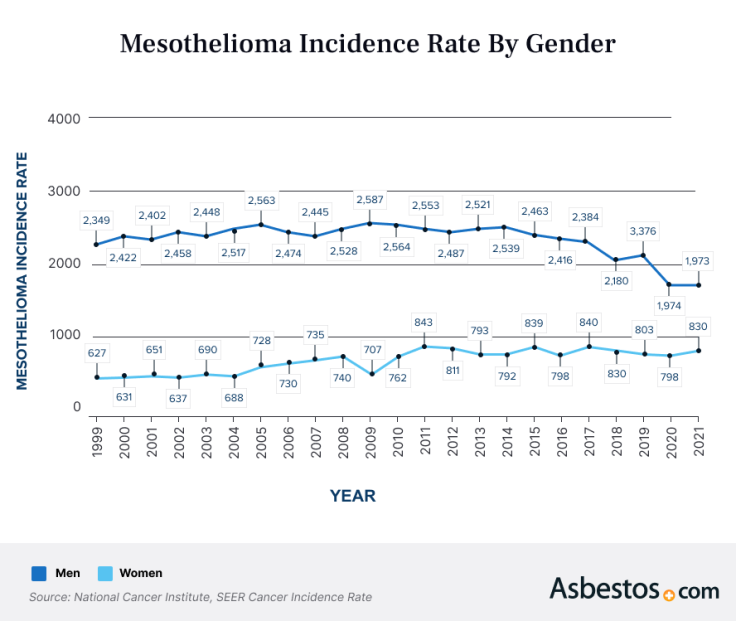
The time from the initial asbestos exposure to when symptoms appear, or latency period, tends to be longer for women than for men. It’s believed this is because a significant percentage of women experienced secondhand exposure over time rather than primary exposure.
Men’s higher rates of heavy occupational asbestos exposure likely result in a shorter latency period. The latency period for men is about 48 years. The latency period for women is about 53 years.
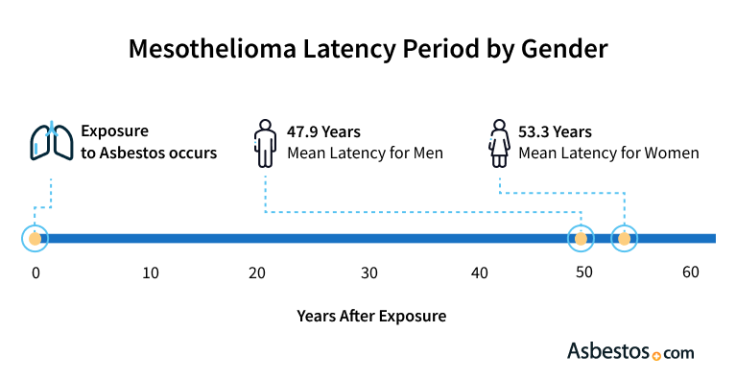
Women tend to have better survival rates than men. For example, the 5-year survival rate for women with pleural mesothelioma is about 16%. For men, it’s around 7%.
However, according to the CDC, mesothelioma deaths among women increased significantly. Mesothelioma cancer deaths for women increased 25% from 1999 to 2020. Combining statistics for both men and women, there were 2,376 mesothelioma deaths in 2020.
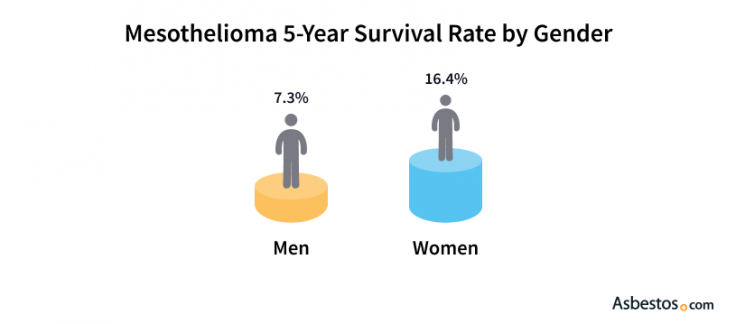
Most people with mesothelioma are non-Hispanic white. In 2021, they made up 81% of all cases. Between 2017 and 2021, the CDC reported 12,174 new cases among whites. In comparison, there were 1,275 cases among Hispanics and 741 cases among non-Hispanic Blacks.
Data from SEER shows that mesothelioma cases in non-Hispanic whites have gone down from 1.3 per 100,000 people in 2000 to 0.8 in 2021. For Hispanic, non-Hispanic Black, and non-Hispanic Asian/Pacific Islander groups, the rates have stayed about the same.
Survival rates also differ by race. In 2015, the 5-year survival rate was about 19% for Black patients, compared to about 9% for white patients.
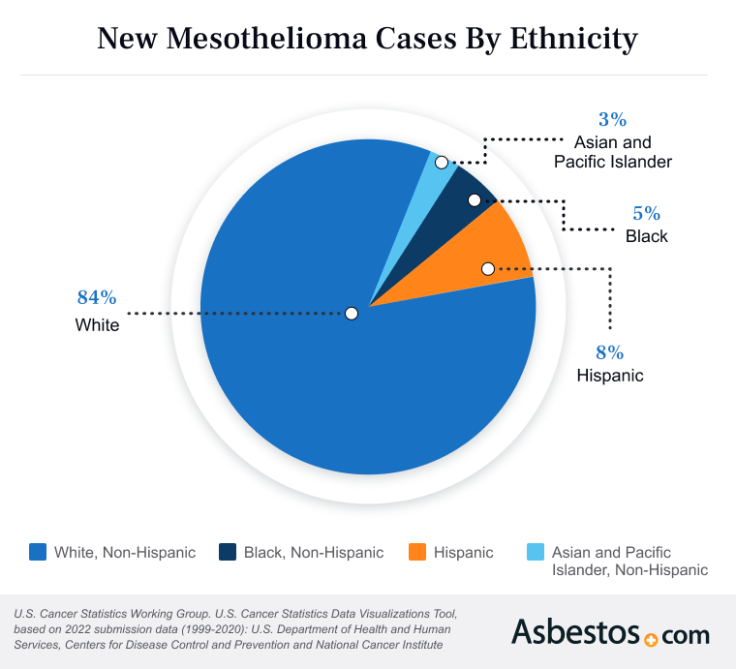
The National Cancer Institute estimates that the first year of lung cancer treatment costs more than $60,000. Mesothelioma treatment costs are similar. These expenses can include hospital bills, lost income, and travel for care.
Some patients may qualify for financial help, like VA benefits or Social Security Disability Insurance. Others may file legal claims, such as asbestos trust fund claims and mesothelioma lawsuits, to help pay for costs.
Mesothelioma Claims and Financial Compensation
Patient Advocate and VA-accredited claims agent Danielle DiPietro explains:
“It’s important for patients and families to seek out financial assistance. You really can’t expect what a diagnosis is going to cost for treatment or at-home care, or what your family’s needs are. So it’s always important to plan for the future.”
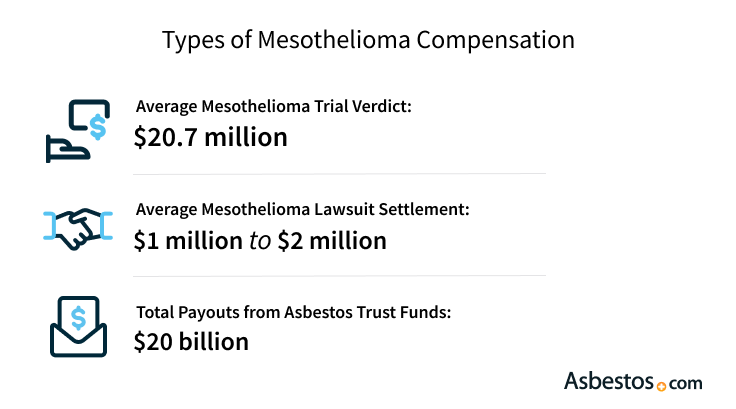

Stay up-to-date on treatment, research, clinical trials, doctors and survivors
The information on this website is proprietary and protected. It is not a substitute for professional medical advice, diagnosis or treatment. Any unauthorized or illegal use, copying or dissemination will be prosecuted. Please read our privacy policy and terms of service for more information about our website.
This website and its content may be deemed attorney advertising. Prior results do not predict a similar outcome.
The Mesothelioma Center’s claim as the most trusted resource is based on our more than 150 5-star Google and BBB reviews. Our organization also helps more than half of all mesothelioma patients annually diagnosed.
Your web browser is no longer supported by Microsoft. Update your browser for more security, speed and compatibility.
If you are looking for mesothelioma support, please contact our Patient Advocates at (855) 404-4592
The Mesothelioma Center at Asbestos.com has provided patients and their loved ones the most updated and reliable information on mesothelioma and asbestos exposure since 2006.
Our team of Patient Advocates includes a medical doctor, a registered nurse, health services administrators, veterans, VA-accredited Claims Agents, an oncology patient navigator and hospice care expert. Their combined expertise means we help any mesothelioma patient or loved one through every step of their cancer journey.
More than 30 contributors, including mesothelioma doctors, survivors, health care professionals and other experts, have peer-reviewed our website and written unique research-driven articles to ensure you get the highest-quality medical and health information.
My family has only the highest compliment for the assistance and support that we received from The Mesothelioma Center. This is a staff of compassionate and knowledgeable individuals who respect what your family is experiencing and who go the extra mile to make an unfortunate diagnosis less stressful. Information and assistance were provided by The Mesothelioma Center at no cost to our family.LashawnMesothelioma patient’s daughter


Asbestos.com. (2025, November 12). Mesothelioma Statistics. Retrieved December 18, 2025, from https://www.asbestos.com/mesothelioma/statistics/
"Mesothelioma Statistics." Asbestos.com, 12 Nov 2025, https://www.asbestos.com/mesothelioma/statistics/.
Asbestos.com. "Mesothelioma Statistics." Last modified November 12, 2025. https://www.asbestos.com/mesothelioma/statistics/.

Dr. Jacques Fontaine is a thoracic surgeon at Moffitt Cancer Center in Tampa, Florida, where he heads up the Mesothelioma Research and Treatment Center. He specializes in minimally invasive robotic surgery and aggressive surgeries for mesothelioma.
Our fact-checking process begins with a thorough review of all sources to ensure they are high quality. Then we cross-check the facts with original medical or scientific reports published by those sources, or we validate the facts with reputable news organizations, medical and scientific experts and other health experts. Each page includes all sources for full transparency.
Please read our editorial guidelines to learn more about our content creation and review process.
